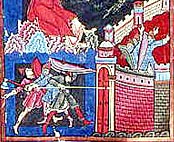![]() The
English Baronial Castle
The
English Baronial Castle
 The
impact of the Norman Conquest in England is, perhaps, most strikingly revealed
by the large number of castles which were built at the time. They served as
fortified strong points and residences for the new Norman lords from which
they set out to conquer and then administer their new domain. Castles were
usually located at strategic points on routes of communication and at centres
of population, including towns, such as Norwich and York, where many buildings
were swept away before construction began.
The
impact of the Norman Conquest in England is, perhaps, most strikingly revealed
by the large number of castles which were built at the time. They served as
fortified strong points and residences for the new Norman lords from which
they set out to conquer and then administer their new domain. Castles were
usually located at strategic points on routes of communication and at centres
of population, including towns, such as Norwich and York, where many buildings
were swept away before construction began.
Early
Norman castles were often of the motte and bailey type. The motte was an
earthen mound composed of material thrown up from the ditch around its base.
On top of the motte there was a timber tower, or keep, which served as a
refuge when the castle was attacked. Access to the motte was gained by means
of a bridge from the bailey. This was a fortified enclosure in which the lord,
his family and closest retainers resided, supplies were kept, and animals were
housed. Of particular importance were the horses which allowed the lord to
reach all parts of his territory quickly and enforce his will.

 Although
some early castle buildings, such as the Tower of London, were stone structures,
it was not until the 12th century that stone was extensively used, principally
for the outer walls, gate house and keep. This was partly because sieges had
become an important part of warfare and stone walls were proof against fire
and missiles, usually large stone balls, hurled by simple siege engines such
as the trebuchet. In addition, stone keeps, which were often built on a grand
scale, afforded more space and a greater degree of comfort to the lord and
his followers than they had enjoyed hitherto. The principal reception and
living room was the great hall, usually on the first floor, but there were
also separate rooms for sleeping and even privies.
Although
some early castle buildings, such as the Tower of London, were stone structures,
it was not until the 12th century that stone was extensively used, principally
for the outer walls, gate house and keep. This was partly because sieges had
become an important part of warfare and stone walls were proof against fire
and missiles, usually large stone balls, hurled by simple siege engines such
as the trebuchet. In addition, stone keeps, which were often built on a grand
scale, afforded more space and a greater degree of comfort to the lord and
his followers than they had enjoyed hitherto. The principal reception and
living room was the great hall, usually on the first floor, but there were
also separate rooms for sleeping and even privies.